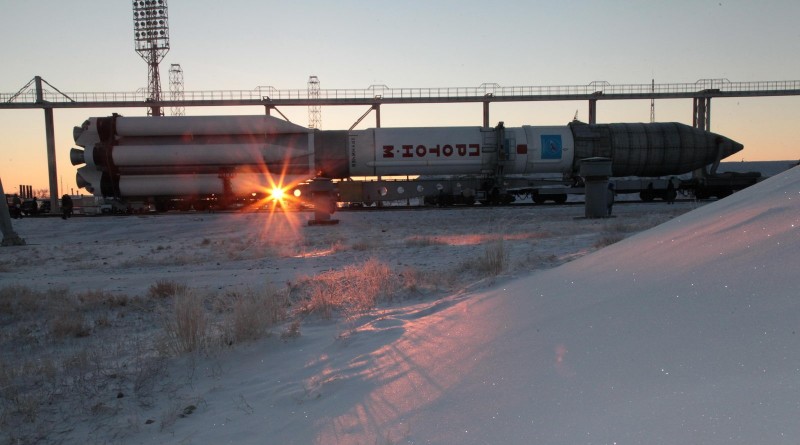Proton-M set for Year-Closing Launch with Ekspress AMU-1 Communications Satellite
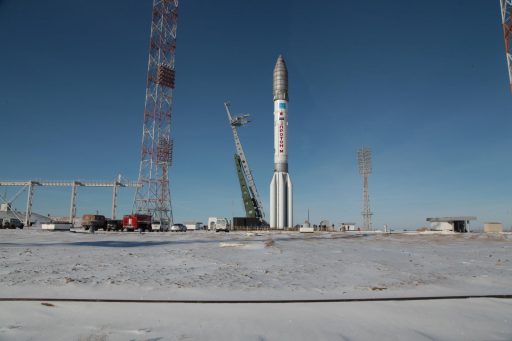
Russia’s Proton-M rocket is set for its year-closing mission on Wednesday, launching the Ekspress AMU-1 communications satellite to Geostationary Transfer Orbit. Liftoff from the Baikonur Cosmodrome is set for 21:30 UTC to mark the start of a standard ascent mission by the three-stage Proton rocket lasting just under ten minutes, to be followed by a flight of over nine hours involving five burns of the Briz-M upper stage to reach the intended orbit.
The Ekspress AMU-1 satellite was built by Airbus Defence and Space for operation by the Russian Satellite Communications Company to expand its services to cater to the growing needs of the Russian digital entertainment market.
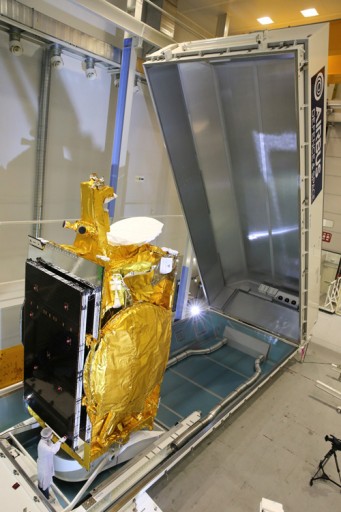
The 5,700-Kilogram satellite carries a Ku/Ka-Band payload of 71 transponders delivering coverage beams to the European portion of Russia and surrounding eastern European countries and to Sub-Saharan Africa. Services delivered by the satellite include TV and video distribution as well as IP-based applications. Residing at 36° East in Geostationary Orbit, the satellite will operate for at least 15 years. A portion of the satellite’s capacity, particularly the African beams, has been leased to Eutelsat to be marketed under the name Eutelsat 36C.
The Ekspress AMU-1 satellite was delivered to the Baikonur Cosmodrome in the first half of November to enter final processing for its launch at the end of the year. As is typical for Russian government-operated flights of the Proton, details on launch preparations were not provided until the rocket was moved to the launch pad on Sunday at a snowy Baikonur Cosmodrome. Placed in its vertical launch position, the 58-meter Proton-M entered a detailed testing campaign to set up for the initiation of the countdown on Wednesday.
The Russian State Commission approved the rocket for tanking, starting at L-6 hours to fill the three stages with 622,000 Kilograms of hypergolic propellants. The Briz-M upper stage received its propellant load, 19,800kg of hypergolics, at a dedicated fueling facility last week.
When the pad is re-opened after fueling, final hands-on work will be completed including the removal of protective covers and the close-out of the rocket and Servicing Structure. One hour ahead of liftoff, the Service Structure is rolled back to a safe position for launch, exposing the fully fueled Proton rocket.
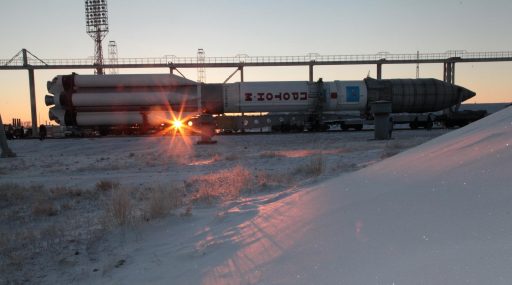
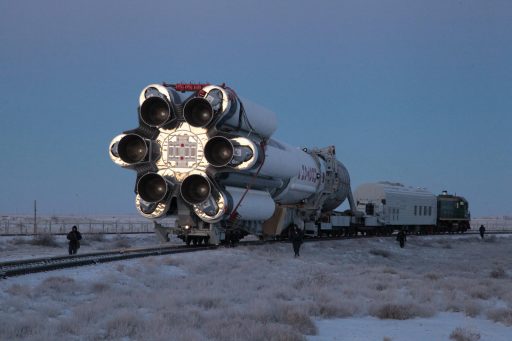
The Master Countdown Sequence gets underway a short time later and a set of reconfigurations is completed to prepare the rocket for the automated countdown sequence that starts at T-5 minutes.
Soaring to life 2.5 seconds before blastoff, Proton’s six engines will reach their liftoff thrust of more than one million Kilogram-force. Liftoff is targeted for precisely 21:30:50 UTC on Wednesday
The Proton rocket will follow its standard ascent profile, beginning with a short vertical ascent before completing a roll maneuver to line up with its precise ascent trajectory.
Proton-M stands 58.2 meters tall and measures 7.4 meters in diameter with a launch mass of 712 metric tons. Its first stage is 21.2 meters long hosting a large oxidizer tank that is surrounded by six fuel tanks holding a total of 419,400 Kilograms of propellants fed to six RD-275M for a liftoff thrust of 9,942 Kilonewtons.
Proton’s second stage has a smaller diameter of 4.15 meters and is 14.5 meters long, holding 156,113kg of propellants to be consumed by a cluster of four RD-0210-type engines. The third stage is 6.5 meters in length launching with a propellant load of 46,562kg. It is powered by a single RD-0213 main engine with a four-chamber RD-0214 vernier.
>>Proton-M / Briz-M Launch Vehicle
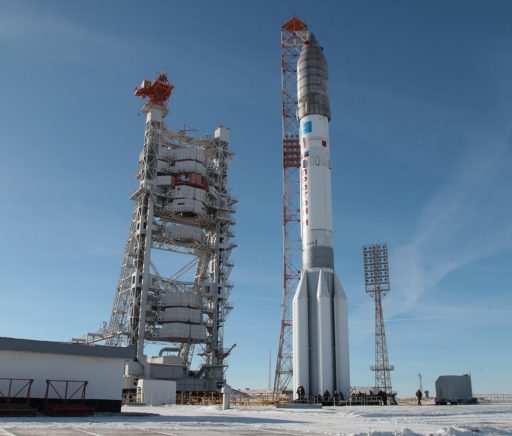
Sitting atop the third stage is the Briz-M Upper Stage that weighs 22 metric tons, being 4.1m in diameter and 2.61m long – consisting of a central section and an Auxiliary Propellant Tank. Briz-M is powered by an 19.6kN S5.98 engine that can support up to eight re-starts. The Upper Stage and Payload are protected by a fairing that is 4.35 meter in diameter and 15 meters long.
Passing Maximum Dynamic Pressure 62 seconds after launch, Proton heads uphill as the first stage rapidly accelerates the vehicle. At T+1:59, the first stage will shut down its engines. As part of hot-staging, the second stage ignites its four 599-Kilonewton RD-0210/0211 engines at the moment of stage separation to continue powered ascent.
The second stage burns until T+5:27. To separate from the second stage, Proton’s third stage will ignite its vernier engine before the large RD-0213 main engine starts its four-minute burn.
Payload Fairing Jettison occurs at T+5:47 and the third stage main engine burns until T+9:31. Three seconds after third stage vernier cutoff at T+9:42, the orbital unit is separated.
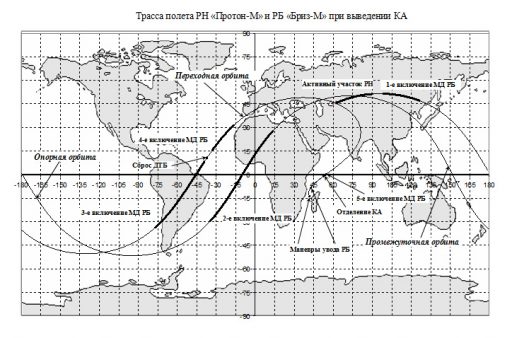
Beginning its five burn mission, the Briz-M upper stage will ignite its S5.98 engine after a very brief coast to conduct a burn of four and a half minutes that puts the stack into a Low Earth Orbit for a coast phase of a little over 50 minutes to set up for a long burn on the ascending node of the orbit with a duration of nearly 18 minutes to raise the apogee of the orbit to 5,000 Kilometers, placing the apogee passage close to the equator.
Next is a coast phase of nearly an entire orbit so that the next burn can again take place around the perigee of the orbit, on the next ascending node, to continue raising the apogee to reach Geostationary Altitude at 35,800 Kilometers. The third and fourth burn are conducted as a pair, amounting to a total of 17.5 minutes, only separated by a brief coast during which the spent Auxiliary Propellant Tank is jettisoned from the Briz-M.
After the conclusion of the fourth burn, Briz-M will coast for over five hours to be able to climb all the way up to the apogee of the orbit for the final burn of the mission that serves as a perigee-raising maneuver and a plane-change, reducing the inclination of the orbit. Spacecraft Separation is expected around nine hours and 13 minutes after launch.

